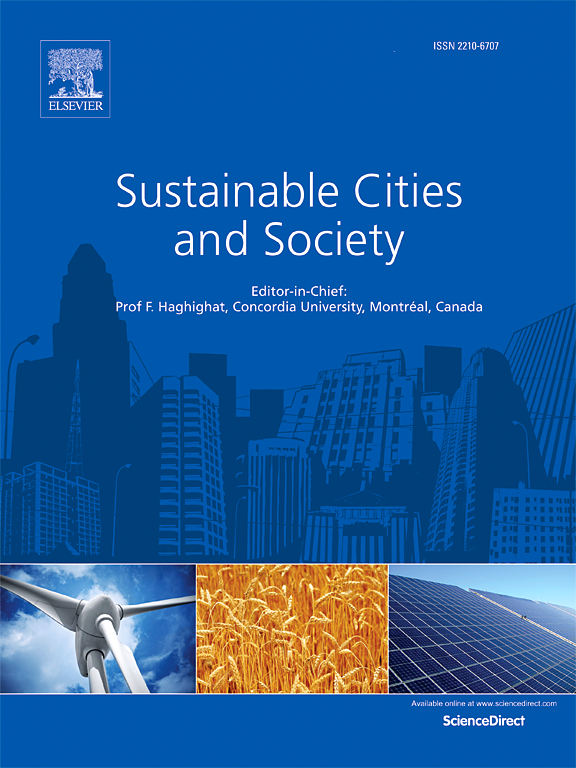A CycleGAN-Pix2pix framework for multi-objective 3D urban morphology optimization: enhancing thermal performance in high-density areas
IF 10.5
1区 工程技术
Q1 CONSTRUCTION & BUILDING TECHNOLOGY
引用次数: 0
Abstract
Enhancing understanding of urban thermal environments is crucial for reducing energy consumption, improving resident comfort, and mitigating urban heat island effects. Previous studies rarely addressed the systematic optimization of local-scale three-dimensional (3D) urban spaces for thermal improvements. This study developed an integrated CycleGAN-Pix2pix-based (CP-GAN) model chain to automatically generate 3D urban morphology coupled with Local Climate Zones (LCZ)and perform performance assessment as well as morphology optimization. The approach was applied to six typical sites in Hong Kong to optimize four variables of urban thermal environments: summer solar radiation (SSR), Universal Thermal Climate Index (UTCI), optimal UTCI area (UTCIA), and floor area ratio variance (FARV). The results showed that (1) CP-GAN model achieved a 0.028 higher average SSIM compared to the previous Pix2pix model, validating its efficiency. (2) The iterated optimal Pareto solutions significantly improved thermal performance compared to the initial morphology, particularly in samples characterized by compact mid-rise buildings, achieving the best optimization results. (3) Four primary optimization strategies were identified: increasing building heights in a suitable interval, reducing building volumes and their variability, expanding green spaces, and arranging building layout rationally. This integrated framework supports sustainable urban design and regeneration, contributing to more livable and resilient cities.
基于CycleGAN-Pix2pix的多目标三维城市形态优化框架:增强高密度区域的热性能
加强对城市热环境的认识对于降低能源消耗、提高居民舒适度和缓解城市热岛效应至关重要。以往的研究很少涉及局地尺度三维(3D)城市空间热改善的系统优化。本研究开发了一个基于cyclegan - pix2pixbased (CP-GAN)的集成模型链,用于自动生成与局部气候带(LCZ)耦合的三维城市形态,并进行性能评估和形态优化。将该方法应用于香港6个典型站点,对夏季太阳辐射(SSR)、通用热气候指数(UTCI)、最优UTCI面积(UTCIA)和容积率方差(FARV) 4个城市热环境变量进行优化。结果表明:(1)与先前的Pix2pix模型相比,CP-GAN模型的平均SSIM提高了0.028,验证了其效率。(2)与初始形态相比,迭代最优Pareto解显著改善了热学性能,特别是在紧凑的中高层建筑中,达到了最佳优化效果。(3)在适宜的区间内增加建筑高度、减少建筑体积及其可变性、扩大绿化空间、合理安排建筑布局是优化的四种主要策略。这一综合框架支持可持续的城市设计和更新,有助于建设更宜居、更有弹性的城市。
本文章由计算机程序翻译,如有差异,请以英文原文为准。
求助全文
约1分钟内获得全文
求助全文
来源期刊

Sustainable Cities and Society
Social Sciences-Geography, Planning and Development
CiteScore
22.00
自引率
13.70%
发文量
810
审稿时长
27 days
期刊介绍:
Sustainable Cities and Society (SCS) is an international journal that focuses on fundamental and applied research to promote environmentally sustainable and socially resilient cities. The journal welcomes cross-cutting, multi-disciplinary research in various areas, including:
1. Smart cities and resilient environments;
2. Alternative/clean energy sources, energy distribution, distributed energy generation, and energy demand reduction/management;
3. Monitoring and improving air quality in built environment and cities (e.g., healthy built environment and air quality management);
4. Energy efficient, low/zero carbon, and green buildings/communities;
5. Climate change mitigation and adaptation in urban environments;
6. Green infrastructure and BMPs;
7. Environmental Footprint accounting and management;
8. Urban agriculture and forestry;
9. ICT, smart grid and intelligent infrastructure;
10. Urban design/planning, regulations, legislation, certification, economics, and policy;
11. Social aspects, impacts and resiliency of cities;
12. Behavior monitoring, analysis and change within urban communities;
13. Health monitoring and improvement;
14. Nexus issues related to sustainable cities and societies;
15. Smart city governance;
16. Decision Support Systems for trade-off and uncertainty analysis for improved management of cities and society;
17. Big data, machine learning, and artificial intelligence applications and case studies;
18. Critical infrastructure protection, including security, privacy, forensics, and reliability issues of cyber-physical systems.
19. Water footprint reduction and urban water distribution, harvesting, treatment, reuse and management;
20. Waste reduction and recycling;
21. Wastewater collection, treatment and recycling;
22. Smart, clean and healthy transportation systems and infrastructure;
 求助内容:
求助内容: 应助结果提醒方式:
应助结果提醒方式:


